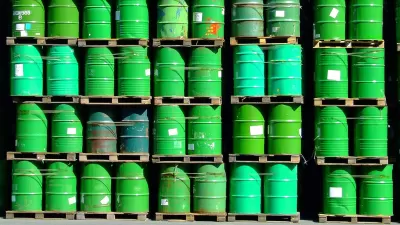Confirming an earlier Dept. of Energy report, the International Energy Agency's World Energy Outlook indicates not only that U.S. oil production will surpass Saudi Arabia's by 2020, but that it will be a net exporter by 2030 - thanks to fracking.
Lananh Nguyen writes on the IEA's annual report, World Energy Outlook and Alix Steel reports via video on the findings of the reputable energy agency representing 28 member countries.
"The U.S. will pump 11.1 million barrels of oil a day in 2020 and 10.9 million in 2025, the IEA said. Those figures are 500,000 barrels a day and 100,000 barrels a day higher, respectively, than its forecasts for Saudi Arabia for those years. The desert kingdom is due to become the biggest producer again by 2030, pumping 11.4 million barrels a day versus 10.2 million in the U.S."
"Around 2017, the U.S. will be the largest oil producer of the world, overtaking Saudi Arabia," IEA Chief Economist Fatih Birol said at a press conference in London today."
However, Birol indicated his disappointment with the inability of the world to enact energy efficiency measures.
"Efforts by global policy makers to promote energy efficiency have been an "epic failure" and fallen short of their economic potential, Birol said. Increased energy-saving measures could cut worldwide oil demand by almost 13 million barrels a day by 2035... Put another way, were efficiency measures suggested by the IEA enacted in full, the increase in world energy demand over the period would be cut in half."
The IEA report confirms an earlier U.S. Dept. of Energy report that was the subject of the Associated Press' Jonathan Fahey article of Oct. 23, "US may soon become world's top oil producer" and discussed in a series of NPR reports on Planetizen, including "NPR Distinguishes Energy Independence From Security".
Damian Carrington, in his Environmental Blog in The Guardian points to the environmental warning contained in the IEA report and overlooked by most media reports that highlight the increased production by the U.S.
"The truly global implications of the International Energy Agency's flagship report for 2012 lie elsewhere, in the quietly devastating statement that no more than one-third of already proven reserves of fossil fuels can be burned by 2050 if the world is to prevent global warming exceeding the danger point of 2C. This means nothing less than leaving most of the world's coal, oil and gas in the ground or facing a destabilised climate, with its supercharged heatwaves, floods and storms..."
Carrington writes that the report turns the idea of 'peak oil' on its head. "The idea of peak oil has gone up in flames. We do not have too little fossil fuel, we have far too much."
Thanks to Mark Boshnack
FULL STORY: U.S. Oil Output to Overtake Saudi Arabia’s by 2020

Alabama: Trump Terminates Settlements for Black Communities Harmed By Raw Sewage
Trump deemed the landmark civil rights agreement “illegal DEI and environmental justice policy.”

Study: Maui’s Plan to Convert Vacation Rentals to Long-Term Housing Could Cause Nearly $1 Billion Economic Loss
The plan would reduce visitor accommodation by 25% resulting in 1,900 jobs lost.

Planetizen Federal Action Tracker
A weekly monitor of how Trump’s orders and actions are impacting planners and planning in America.

Wind Energy on the Rise Despite Federal Policy Reversal
The Trump administration is revoking federal support for renewable energy, but demand for new projects continues unabated.

Passengers Flock to Caltrain After Electrification
The new electric trains are running faster and more reliably, leading to strong ridership growth on the Bay Area rail system.

Texas Churches Rally Behind ‘Yes in God’s Back Yard’ Legislation
Religious leaders want the state to reduce zoning regulations to streamline leasing church-owned land to housing developers.
Urban Design for Planners 1: Software Tools
This six-course series explores essential urban design concepts using open source software and equips planners with the tools they need to participate fully in the urban design process.
Planning for Universal Design
Learn the tools for implementing Universal Design in planning regulations.
Caltrans
Smith Gee Studio
Institute for Housing and Urban Development Studies (IHS)
City of Grandview
Harvard GSD Executive Education
Toledo-Lucas County Plan Commissions
Salt Lake City
NYU Wagner Graduate School of Public Service




























